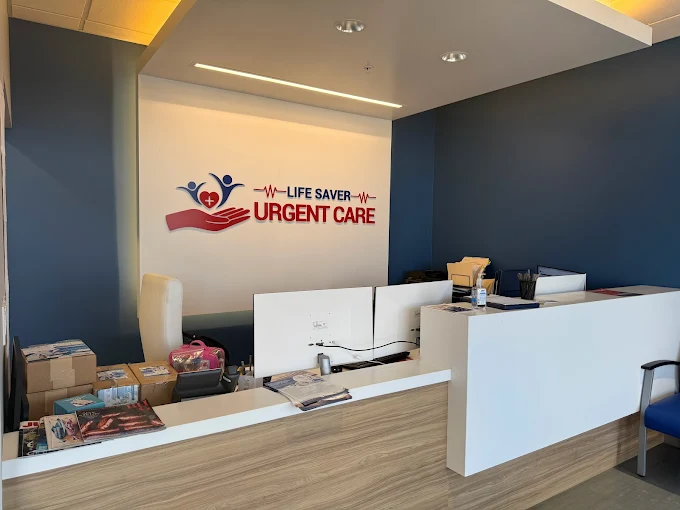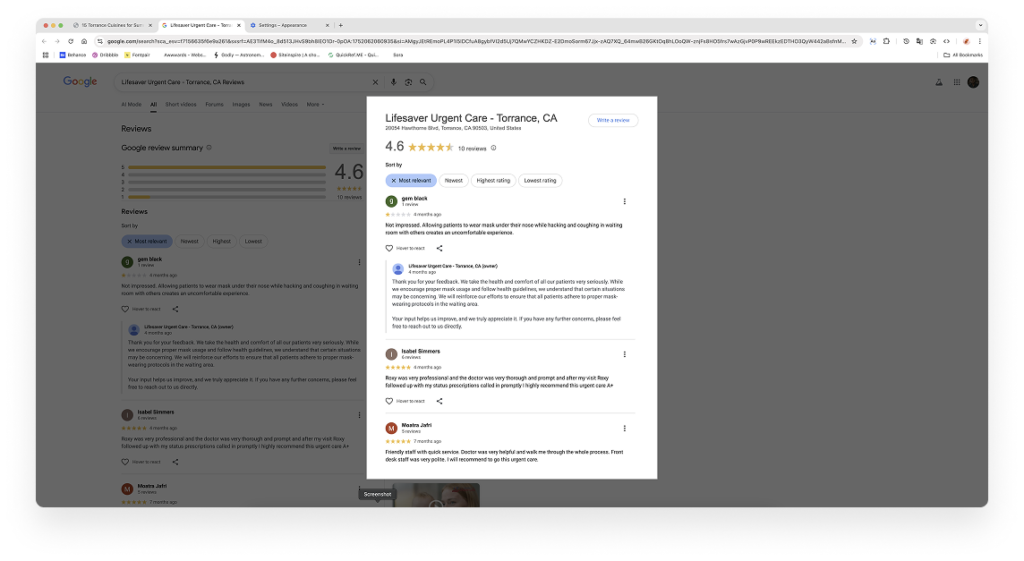Table of Contents
ToggleWhy Urgent Care is Ideal for Common Health Issues
Weird but true 24 hours lies in our hands as an illusion especially in this modern world, with so many things to handle on our plate we just don’t have the time for something that pops up unplanned.
Imagine a working mother suddenly has kids who are sick and just when she has taken care of them, she falls sick. It is not easy to handle back-to-back situations, especially when it comes to healthcare.
2025, healthcare demands agility, accessibility, and affordability. Vital solutions in the healthcare industry for ailments like flu, minor injuries, and infections are effectively offered by Urgent care services. A long-standing problem with urgent cares in the past were long wait times and unorganized appointments which has been tackled by almost all urgent cares with the boom in technology and Life Saver Urgent Care stands out as a trusted provider, offering expert care without the long wait times of emergency rooms or the scheduling hassles of primary care.
There are over 11,000 urgent care centers in the U.S. and a 15% increase in patient visits from 2023 to 2025, walk-in clinics like Life Saver are redefining healthcare convenience as people book their appointments quicker than the wait in a hospital or ER. For non-life threatening Emergency cases and other minor healthcare ailments Urgent Care near you is your best bet.
This guide explores how Life Saver Urgent Care addresses common ailments in Torrance, when to seek care, and how to prevent health issues. From diagnostic capabilities to cost transparency, we’ll walk you through what makes Life Saver the urgent care near you in Torrance, California.
Common Conditions Treated at Life Saver Urgent Care
Life Saver Urgent Care is equipped to handle a wide range of non-emergency conditions, ensuring patients receive prompt treatment. Below are the most common health issues treated at Life Saver clinics, along with how they’re managed.
Flu and Respiratory Infections
- Diagnosis: Life Saver uses rapid flu tests, delivering results in 10-15 minutes.
- Treatment: Antiviral medications (e.g., Tamiflu) may be prescribed within 48 hours of symptom onset to reduce severity. Supportive care, like hydration advice, is also provided.
- Why Life Saver? On-site labs ensure quick diagnosis, and telehealth options allow remote consultations for mild cases.
Minor Injuries: Sprains, Strains, and Cuts
Sprains and Strains
Clinicians assess injuries with physical exams and, if needed, X-rays to rule out fractures. Treatment includes RICE (Rest, Ice, Compression, Elevation) protocols and bracing.
Cuts and Lacerations
Why Life Saver? Same-day care minimizes recovery time, and follow-up telehealth visits monitor progress.
Allergies and Skin Conditions
Seasonal allergies and skin issues like rashes or hives are increasingly common, with 25% of Americans reporting allergies in 2025. American Academy of Allergy, Asthma & Immunology Life Saver Urgent Care addresses these with tailored solutions.
- Allergies: Providers prescribe antihistamines or corticosteroids and offer advice on allergen avoidance.
- Skin Conditions: Rashes, hives, or minor burns are evaluated, with topical treatments or referrals to dermatologists if needed.
Why Life Saver?
Comprehensive evaluations distinguish between allergic reactions and infections, ensuring accurate treatment.
Urinary Tract Infections (UTIs)
UTIs affect over 8 million Americans annually, predominantly women (National Kidney Foundation, 2024). Symptoms like burning during urination or frequent urges require prompt care to prevent complications.
- Diagnosis: Life Saver performs urinalysis and urine cultures on-site for quick results.
- Treatment: Antibiotics are prescribed, with follow-up guidance to prevent recurrence.
- Why Life Saver?: Rapid testing and same-day prescriptions reduce discomfort and recovery time.
Gastrointestinal Issues
Stomach issues, such as nausea, vomiting, or diarrhea, often stem from food poisoning or viral gastroenteritis. Life Saver Urgent Care offers immediate relief for these distressing symptoms.
- Diagnosis: Clinicians assess dehydration risks and may order lab tests to identify causes.
- Treatment: Rehydration therapy, anti-nausea medications, and dietary advice are provided.
- Why Life Saver?: Same-day care prevents complications like severe dehydration, especially in children and seniors.
Annual Physicals
Annual physicals are essential for maintaining overall health and catching potential issues early. According to the CDC , regular check-ups can reduce the risk of chronic diseases by 20%. Life Saver Urgent Care offers convenient walk-in clinic physicals for adults, eliminating the need for primary care appointments.
- Diagnosis: Providers conduct comprehensive exams, including vital signs (blood pressure, heart rate), blood tests (cholesterol, glucose), and screenings for conditions like diabetes or hypertension.
- Treatment: If abnormalities are detected, Life Saver provides immediate recommendations, prescriptions, or referrals to specialists. Preventive advice, such as lifestyle changes, is also offered.
- Why Life Saver?: No appointments are needed, and on-site labs deliver quick results, making annual physicals accessible for busy individuals.
Sports Physicals
Sports physicals, or pre-participation physical examinations (PPEs), are required for student-athletes to ensure safe participation in sports. With over 7 million high school athletes in the U.S. (National Federation of State High School Associations, 2024), Life Saver Urgent Care provides fast, thorough evaluations.
- Diagnosis: Clinicians assess cardiovascular health, musculoskeletal function, and medical history to clear athletes for sports. Tests like vision screenings or EKGs may be included for high-risk cases.
- Treatment: If minor issues (e.g., mild asthma) are identified, Life Saver offers treatment plans or clearance with precautions. Documentation is provided for schools or sports organizations.
- Why Life Saver?: Walk-in availability and quick turnaround times ensure athletes meet deadlines without delays.
Pediatrics
Life Saver Urgent Care offers specialized care for children, addressing common pediatric conditions like ear infections, fevers, or minor injuries. With 25% of urgent care visits involving children, Life Saver’s child-friendly approach ensures comfort and safety.
- Diagnosis: Pediatric providers use gentle techniques and rapid tests (e.g., strep throat, flu) to diagnose conditions. On-site labs and imaging support accurate assessments.
- Treatment: Treatments include age-appropriate medications, such as liquid antibiotics, and parental guidance on home care. Telehealth options are available for follow-ups or mild cases.
- Why Life Saver?: Child-friendly staff, colorful exam rooms, and minimal wait times reduce stress for kids and parents.
When to Visit Life Saver vs. Primary Care or ER
Urgent Care at Life Saver
Life Saver is best for conditions that need prompt care but aren’t life-threatening. Examples include:
- Flu and colds: Rapid testing and treatment for respiratory illnesses.
- Minor injuries: Sprains, minor fractures, cuts, or burns.
- Infections: UTIs, ear infections, or skin infections.
- Allergies: Seasonal allergies or mild allergic reactions.
- Average Wait Time: Under 30 minutes, with online check-ins to skip the queue.
Primary Care
Primary care is suited for ongoing health management, such as:
- Chronic conditions (e.g., diabetes, hypertension).
- Routine check-ups and screenings.
- Preventive care like vaccinations.
- Note: Primary care often requires appointments, which can delay care for urgent issues.
Emergency Room
The ER is reserved for life-threatening conditions, including:
- Chest pain or difficulty breathing.
- Severe bleeding or head trauma.
- Suspected stroke or heart attack.
- Loss of consciousness.
| S. NO | Condition | Life Saver Urgent Care | Primary Care | ER |
|---|---|---|---|---|
| 1 | Flu or fever | ✅ | ||
| 2 | Sprained ankle | ✅ | ||
| 3 | Annual physical | ✅ | ||
| 4 | Chest pain | ✅ | ||
| 5 | UTI | ✅ | ✅ | |
| 6 | Severe allergic reaction | ✅ |
Preventive Health Tips from Life Saver Experts
Flu Prevention
- Get Vaccinated: The CDC recommends annual flu shots for everyone over 6 months, reducing flu risk by up to 60%. Life Saver offers walk-in flu vaccinations.
- Hand Hygiene: Wash hands frequently with soap for 20 seconds to prevent viral spread.
- Boost Immunity: Eat a balanced diet rich in fruits, vegetables, and lean proteins to support immune health.
Injury Prevention
- Warm-Up Before Exercise: Stretch and warm up to avoid sprains or strains.
- Use Proper Gear: Wear supportive shoes or protective equipment during sports.
- Home Safety: Remove tripping hazards and use non-slip mats to prevent falls.
Allergy Management
- Monitor Pollen Counts: Use apps like Pollen.com to avoid high-pollen days.
- Use Air Filters: HEPA filters in homes to reduce indoor allergens.
- Consult Life Saver: Get allergy testing or prescriptions for persistent symptoms.
UTI Prevention
- Stay Hydrated: Drink 8-10 glasses of water daily to flush bacteria.
- Practice Good Hygiene: Wipe front to back and urinate after intercourse to reduce infection risk.
- Avoid Irritants: Limit caffeine and alcohol, which can irritate the bladder.
Gastrointestinal Health
- Food Safety: Cook meats to safe temperatures and refrigerate leftovers promptly.
- Probiotics: Incorporate yogurt or supplements to support gut health.
- Hydration: Sip water or electrolyte drinks during stomach upset to prevent dehydration.
- Pro Tip: Visit Life Saver Urgent Care for preventive services like vaccinations or health screenings to stay ahead of common issues.
Life Saver’s Diagnostic Capabilities
Accurate diagnosis is the cornerstone of effective treatment. Life Saver Urgent Care invests in advanced diagnostic tools to ensure precise, timely care.
On-Site X-Rays
Common Uses: Assessing sprains, fractures, or pneumonia.
Why Life Saver?: Board-certified radiologists review images, ensuring accuracy.
Laboratory Testing
Life Saver’s on-site labs perform rapid tests for flu, strep throat, UTIs, and more. Blood tests for glucose or cholesterol levels are also available for comprehensive evaluation.
- Turnaround Time: Most results are ready in 10-20 minutes.
- Why Life Saver?: Eliminates the need for separate lab visits, saving time.
Point-of-Care Testing
Point-of-care tests, like rapid COVID-19 or glucose monitoring, provide instant results. This is critical for conditions requiring immediate intervention, such as infections or allergic reactions.
Example: A rapid strep test confirms strep throat in 5 minutes, allowing same-day antibiotic prescriptions.
Patient Guide: What to Expect at Life Saver Urgent Care
Before Your Visit
- Online Check-In: Use Life Saver’s website or app to reserve a spot, reducing wait times.
- Insurance Verification: Check if Life Saver accepts your insurance online or bring your card.
- Prepare Information: Note symptoms, medical history, and medications for faster consultations.
During Your Visit
- Check-In: Arrive at the clinic and complete minimal paperwork (often digital).
- Triage: A nurse assesses your condition to prioritize care.
- Consultation: A board-certified provider evaluates your symptoms, orders tests if needed, and discusses treatment.
- Diagnostics and Treatment: On-site X-rays, labs, or prescriptions are provided as needed.
- Average Time: Most visits take 30-60 minutes, depending on the tests required.
After Your Visit
- Prescriptions: Medications are sent electronically to your preferred pharmacy.
- Follow-Up: Telehealth or in-person follow-ups ensure recovery.
- Patient Portal: Access test results, bills, or medical records online.

Patient Feedback
– Ms. Moatra Jafri,
2025 patient.
- Isabel Simmers,
2025 patient
Cost and Insurance Options at Life Saver
WE ACCEPT MOST MAJOR
INSURANCE PLANS
Contact your insurance company to check coverage options.








Insurance Coverage
Cash-Pay Options
Billing Transparency
- Upfront Estimates: Patients receive cost estimates before treatment.
- Online Payments: Pay bills via Life Saver’s secure patient portal.
- Insurance Claims: Life Saver handles claim to minimize patient effort.
FAQs About Common Health Concerns
What conditions can Life Saver Urgent Care treat?
When should I visit Life Saver instead of the ER?
Can Life Saver prescribe medications?
How quickly can I be seen at Life Saver?
What are the Locations covered by Life Saver Urgent Care?
Life Saver Urgent Care is located at 20054 Hawthorne Blvd, Torrance, CA 90503. However, we have patients and individuals visiting us from the neighborhood. Families from Madrona, Riviera, Seaside, Pueblo, Hillside and Southwood visit our urgent care clinic.
For people who visit us from other locations are – Torrance

